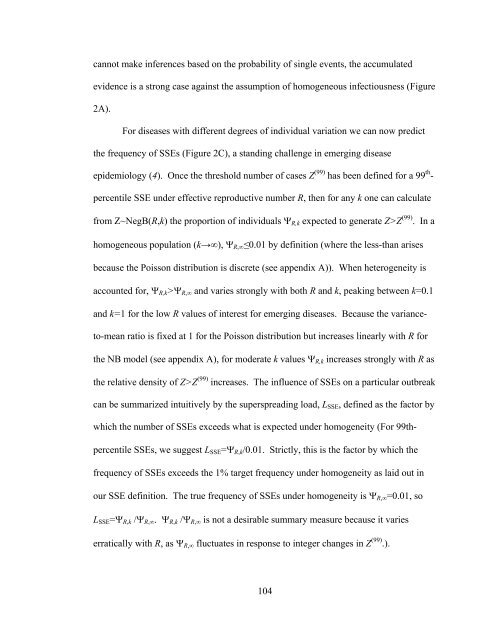K - College of Natural Resources - University of California, Berkeley
K - College of Natural Resources - University of California, Berkeley
K - College of Natural Resources - University of California, Berkeley
Create successful ePaper yourself
Turn your PDF publications into a flip-book with our unique Google optimized e-Paper software.
cannot make inferences based on the probability <strong>of</strong> single events, the accumulated<br />
evidence is a strong case against the assumption <strong>of</strong> homogeneous infectiousness (Figure<br />
2A).<br />
For diseases with different degrees <strong>of</strong> individual variation we can now predict<br />
the frequency <strong>of</strong> SSEs (Figure 2C), a standing challenge in emerging disease<br />
epidemiology (4). Once the threshold number <strong>of</strong> cases Z (99) has been defined for a 99 th -<br />
percentile SSE under effective reproductive number R, then for any k one can calculate<br />
from Z~NegB(R,k) the proportion <strong>of</strong> individuals ΨR,k expected to generate Z>Z (99) . In a<br />
homogeneous population (k→∞), ΨR,∞≤0.01 by definition (where the less-than arises<br />
because the Poisson distribution is discrete (see appendix A)). When heterogeneity is<br />
accounted for, ΨR,k>ΨR,∞ and varies strongly with both R and k, peaking between k=0.1<br />
and k=1 for the low R values <strong>of</strong> interest for emerging diseases. Because the variance-<br />
to-mean ratio is fixed at 1 for the Poisson distribution but increases linearly with R for<br />
the NB model (see appendix A), for moderate k values ΨR,k increases strongly with R as<br />
the relative density <strong>of</strong> Z>Z (99) increases. The influence <strong>of</strong> SSEs on a particular outbreak<br />
can be summarized intuitively by the superspreading load, LSSE, defined as the factor by<br />
which the number <strong>of</strong> SSEs exceeds what is expected under homogeneity (For 99th-<br />
percentile SSEs, we suggest LSSE=ΨR,k/0.01. Strictly, this is the factor by which the<br />
frequency <strong>of</strong> SSEs exceeds the 1% target frequency under homogeneity as laid out in<br />
our SSE definition. The true frequency <strong>of</strong> SSEs under homogeneity is ΨR,∞=0.01, so<br />
LSSE=ΨR,k /ΨR,∞. ΨR,k /ΨR,∞ is not a desirable summary measure because it varies<br />
erratically with R, as ΨR,∞ fluctuates in response to integer changes in Z (99) .).<br />
104

















